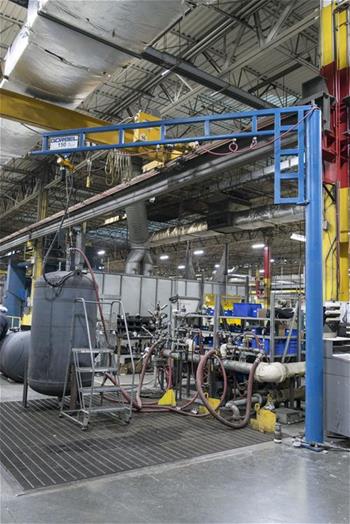As a safety manager or plant operator, you would likely agree that two of your top goals are to maximize productivity and promote workplace safety. One of the best ways to achieve both of these goals is to install one or more ergonomic jib cranes at your facility. In addition to helping your team increase their product loading and unloading efficiency, jib cranes can be used in many different types of applications. Below is a look at some of the most popular styles of ergonomic jib cranes and the various ways they contribute to higher productivity. 
What are some of the most popular styles of jib cranes?
Jib cranes exist in multiple configurations to support a variety of applications. Examples of workplaces that use jib cranes include warehouses, military facilities, equipment manufacturers, and order fulfillment providers. In general, jib cranes are categorized according to their mounting configuration. Here is a look at some of the most popular styles of jib cranes:
- Fixed Wall Mount: Fixed wall mount cranes are mounted horizontally on your facility wall. Hoisting properties are similar to those on a floor mounted crane but there is no vertical boom. Rather than having a vertical shaft, they have a column bracket that permits partial rotation.
- Traveling Wall Mount: Like fixed wall mount jib cranes, traveling wall mount jibs mount horizontally to your wall. However, they are installed using a track mount system. This permits the entire crane to travel longitudinally across work stations to carry and deliver loads.
- Floor Mounted: As the most widely used type of jib crane, a floor mounted jib crane is manually operated and is able to rotate 360 degrees. They are manufactured in a wide array of heights and spans and feature a large floor plate for secure mounting.
How do ergonomic jib cranes help boost productivity?
There are no shortcuts when it comes to productivity and heavy lifting. Cutting corners by using the incorrect cranes or equipment can hinder your production and leave your employees and products at increased risk for accidents. Jib cranes can help you avoid these pitfalls and optimize productivity by offering the benefits below:
1) They are easy to install
The path to improved productivity begins with simple and fast installation. Jib cranes are known for being relatively easy to install, which minimizes production downtime. In fact, the most challenging part of the installation process is often confirming that building columns and walls are structurally sound enough to support the jib crane you would like to add.
2) Adjustments require little downtime
The industrial landscape is constantly evolving, requiring businesses to adapt their operations and equipment to address production demands. Jib cranes feature a console bearing that enables production staff to make rapid adjustments that do not require complete disassembly. With quick adjustments possible, production downtime is minimized.
3) They require less maintenance than larger cranes
Jib cranes are known for their durability and long lifespans. They require little in the way of preventive maintenance, delighting plant managers and further reducing downtime. De-installing jib cranes is also fairly simple and you can easily relocate a jib to another area of your facility for use in a different capacity.
4) You can use the same crane across multiple workstations
For example, if your facility is organized with five workstations side by side against a single wall, you can install a traveling wall mount jib crane that can traverse your entire wall - thereby serving all of your workstations. This setup is particularly useful for facilities whose lifting needs are more sporadic than constant.
5) They maximize loading and unloading efficiency
The ability for jib cranes to rotate makes them an excellent addition to loading docks and in machining areas. For example, they can easily unload heavy steel pipes from flatbed trucks, then pivot and lay the piping on a concrete floor or slab. Floor mounted models are especially useful in indoor and outdoor loading areas due to their ability to rotate 360°.
6) They provide excellent reach
Jibs offer superb reach capabilities - especially when prepared to standard hoists. While hoists are able to retrieve items, lift them up, and sit them down at a higher location, most standard hoists are not designed to move loads to a new location. Jib cranes are able to accomplish this feat with ease.
7) They offer superb strength
Jib cranes possess a surprising degree of strength - especially considering their impressive ergonomic design. While maximum lifting capacity will vary according to style and model, jibs are constructed to hold a load on their own, while other elements of the jib crane are designed to be equally strong.
8) They can supplement your existing cranes
A lesser known benefit of jib cranes is their ability to be used alongside a larger crane to provide additional support. For example, a free-standing jib can be used along with an overhead crane. If you decide to use a jib crane in this capacity, be sure to select one that is designed to safeguard against dislodgement and potential damage.
How does your jib crane help you boost productivity in your facility?